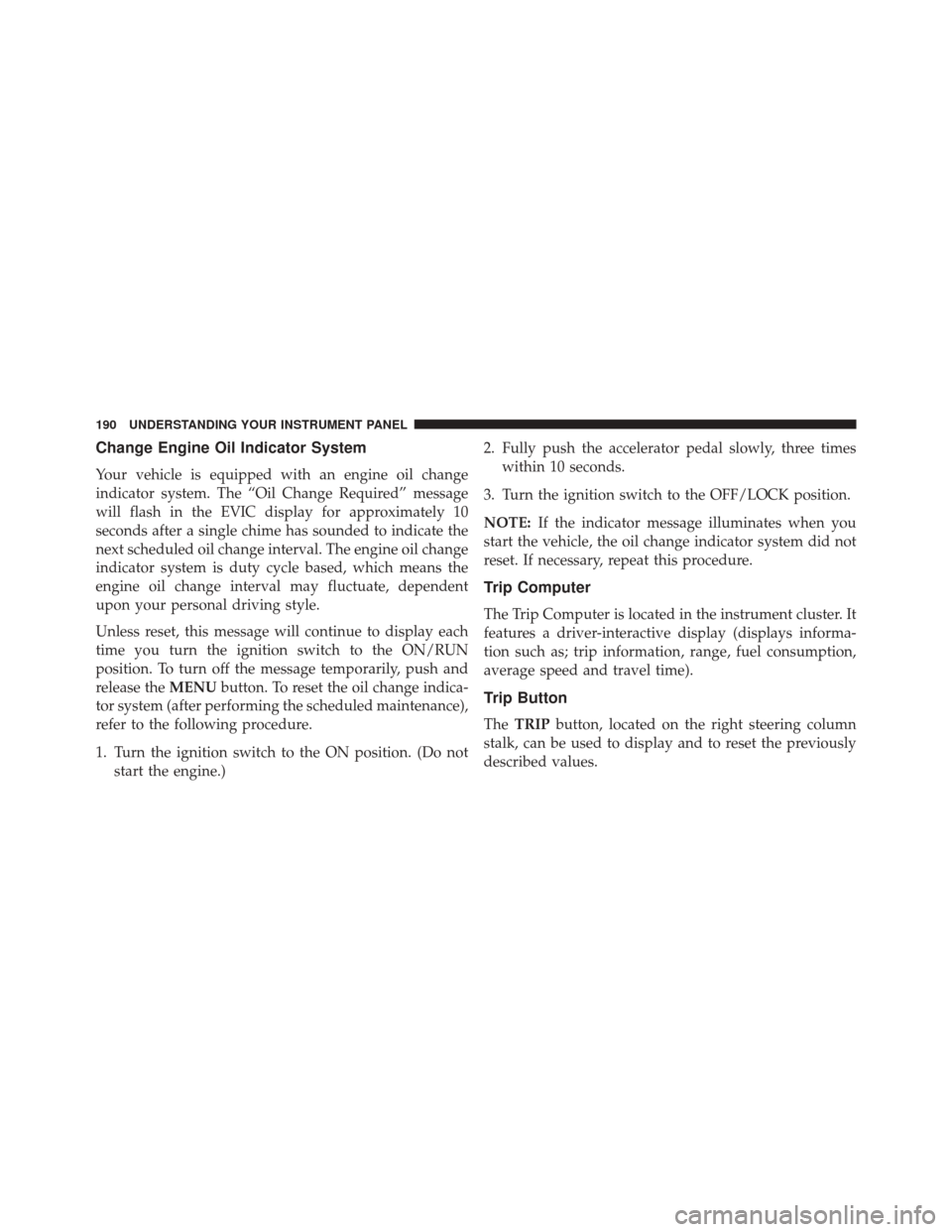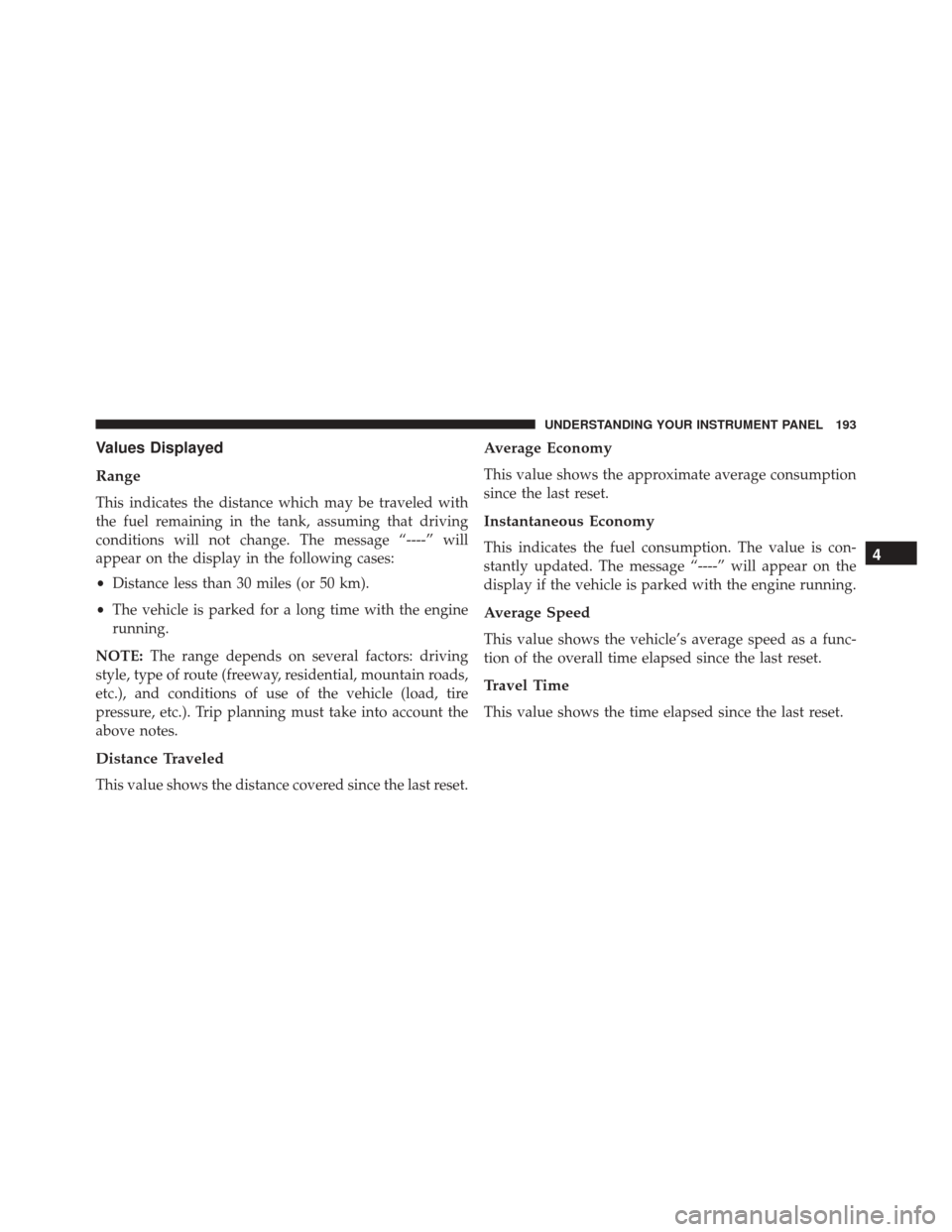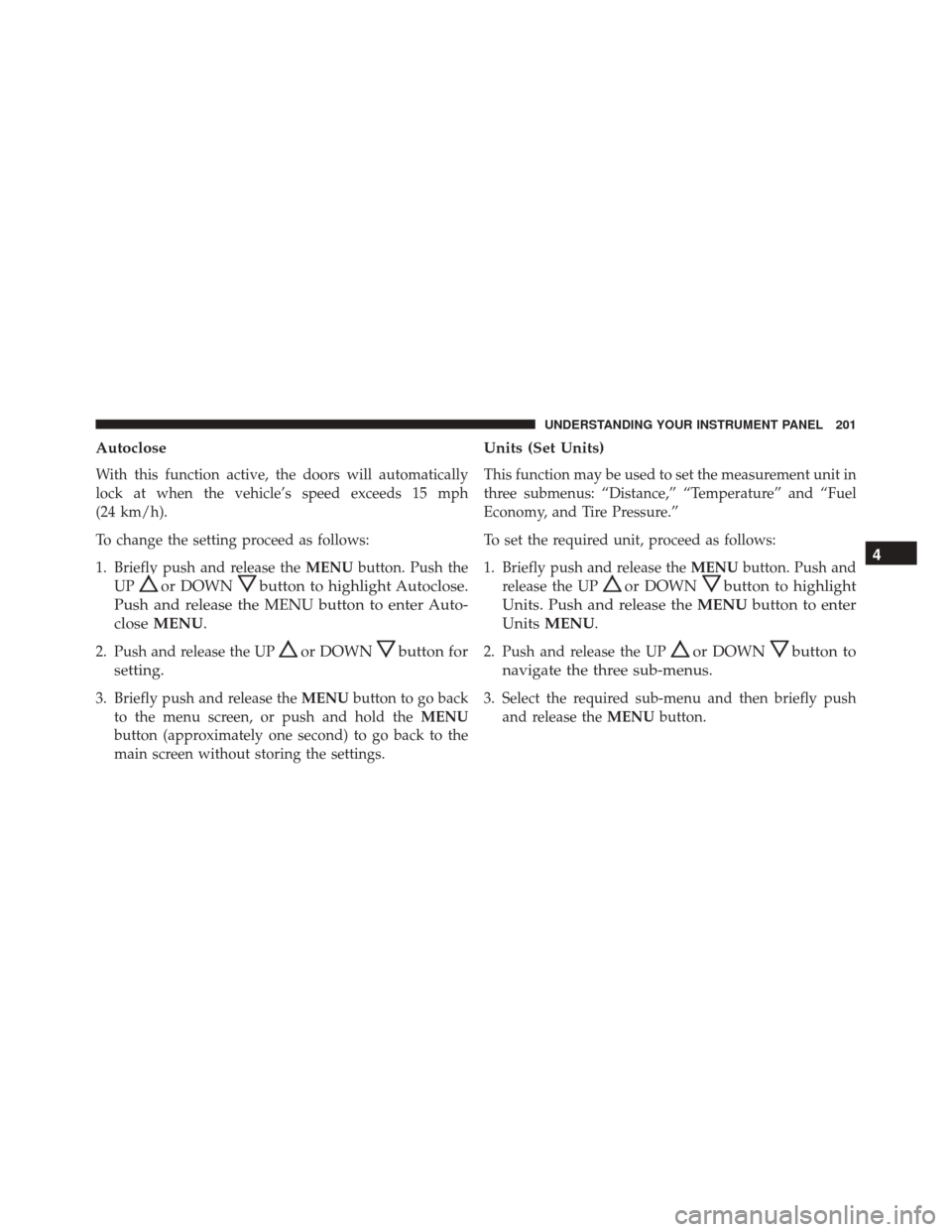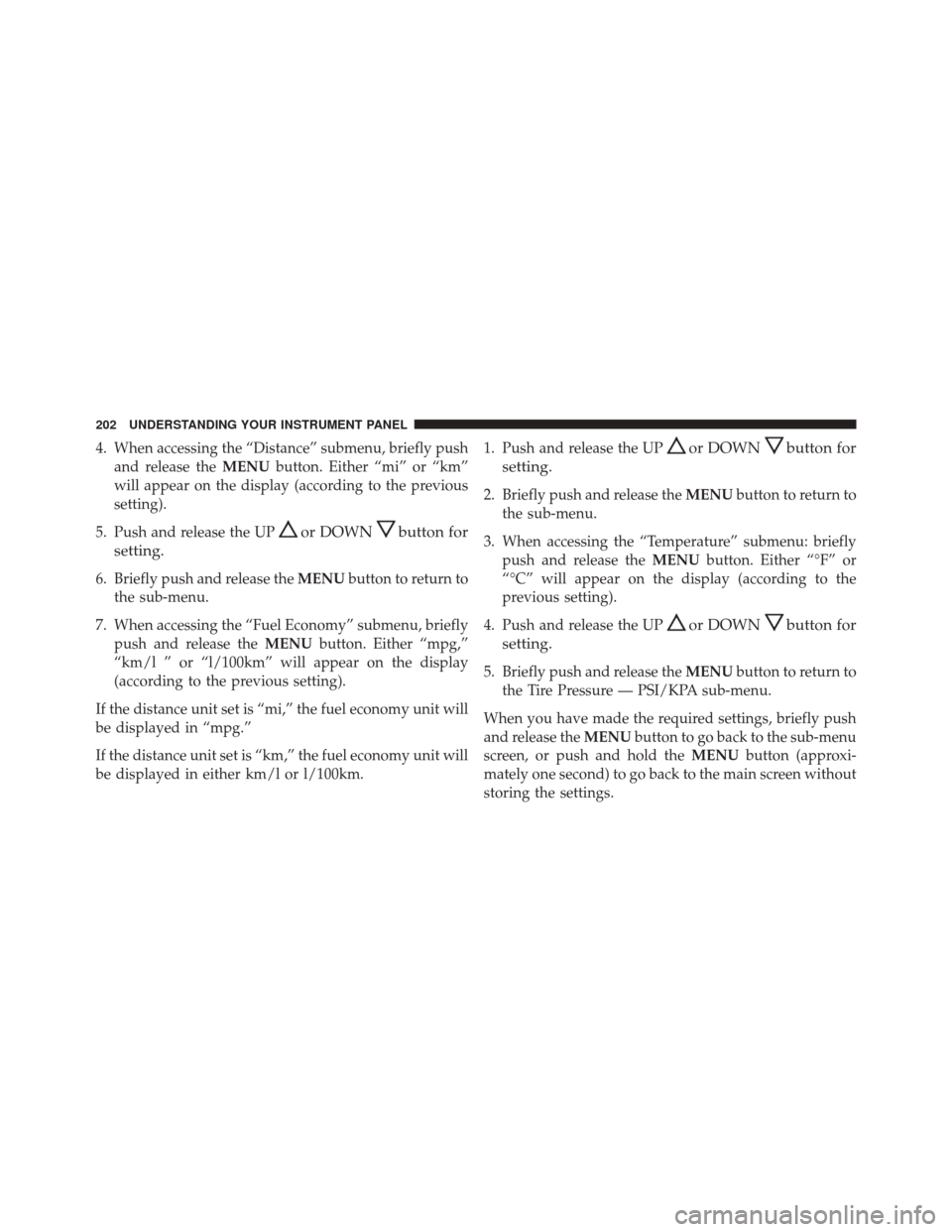Page 183 of 476

one or more of your tires is significantly under-inflated.
Accordingly, when the low tire pressure telltale illumi-
nates, you should stop and check your tires as soon as
possible and inflate them to the proper pressure. Driving
on a significantly under-inflated tire causes the tire to
overheat and can lead to tire failure. Under-inflation also
reduces fuel efficiency and tire tread life, and may affect
the vehicle’s handling and stopping ability.
Please note that the TPMS is not a substitute for proper
tire maintenance, and it is the driver ’s responsibility to
maintain correct tire pressure, even if under-inflation has
not reached the level to trigger illumination of the TPMS
low tire pressure telltale.
Your vehicle has also been equipped with a TPMS
malfunction indicator to indicate when the system is not
operating properly. The TPMS malfunction indicator is
combined with the low tire pressure telltale. When the
system detects a malfunction, the telltale will flash forapproximately one minute and then remain continuously
illuminated. This sequence will continue upon subse-
quent vehicle start-ups as long as the malfunction exists.
When the malfunction indicator is illuminated, the sys-
tem may not be able to detect or signal low tire pressure
as intended. TPMS malfunctions may occur for a variety
of reasons, including the installation of replacement or
alternate tires or wheels on the vehicle that prevent the
TPMS from functioning properly. Always check the
TPMS malfunction telltale after replacing one or more
tires or wheels on your vehicle, to ensure that the
replacement or alternate tires and wheels allow the TPMS
to continue to function properly.
CAUTION!
The TPMS has been optimized for the original
equipment tires and wheels. TPMS pressures and
(Continued)
4
UNDERSTANDING YOUR INSTRUMENT PANEL 181
Page 192 of 476

Change Engine Oil Indicator System
Your vehicle is equipped with an engine oil change
indicator system. The “Oil Change Required” message
will flash in the EVIC display for approximately 10
seconds after a single chime has sounded to indicate the
next scheduled oil change interval. The engine oil change
indicator system is duty cycle based, which means the
engine oil change interval may fluctuate, dependent
upon your personal driving style.
Unless reset, this message will continue to display each
time you turn the ignition switch to the ON/RUN
position. To turn off the message temporarily, push and
release theMENUbutton. To reset the oil change indica-
tor system (after performing the scheduled maintenance),
refer to the following procedure.
1. Turn the ignition switch to the ON position. (Do not start the engine.) 2. Fully push the accelerator pedal slowly, three times
within 10 seconds.
3. Turn the ignition switch to the OFF/LOCK position.
NOTE: If the indicator message illuminates when you
start the vehicle, the oil change indicator system did not
reset. If necessary, repeat this procedure.
Trip Computer
The Trip Computer is located in the instrument cluster. It
features a driver-interactive display (displays informa-
tion such as; trip information, range, fuel consumption,
average speed and travel time).
Trip Button
The TRIP button, located on the right steering column
stalk, can be used to display and to reset the previously
described values.
190 UNDERSTANDING YOUR INSTRUMENT PANEL
Page 195 of 476

Values Displayed
Range
This indicates the distance which may be traveled with
the fuel remaining in the tank, assuming that driving
conditions will not change. The message “----” will
appear on the display in the following cases:
•Distance less than 30 miles (or 50 km).
• The vehicle is parked for a long time with the engine
running.
NOTE: The range depends on several factors: driving
style, type of route (freeway, residential, mountain roads,
etc.), and conditions of use of the vehicle (load, tire
pressure, etc.). Trip planning must take into account the
above notes.
Distance Traveled
This value shows the distance covered since the last reset.
Average Economy
This value shows the approximate average consumption
since the last reset.
Instantaneous Economy
This indicates the fuel consumption. The value is con-
stantly updated. The message “----” will appear on the
display if the vehicle is parked with the engine running.
Average Speed
This value shows the vehicle’s average speed as a func-
tion of the overall time elapsed since the last reset.
Travel Time
This value shows the time elapsed since the last reset.
4
UNDERSTANDING YOUR INSTRUMENT PANEL 193
Page 203 of 476

Autoclose
With this function active, the doors will automatically
lock at when the vehicle’s speed exceeds 15 mph
(24 km/h).
To change the setting proceed as follows:
1. Briefly push and release theMENUbutton. Push the
UP
or DOWNbutton to highlight Autoclose.
Push and release the MENU button to enter Auto-
close MENU.
2. Push and release the UPor DOWNbutton for
setting.
3. Briefly push and release the MENUbutton to go back
to the menu screen, or push and hold the MENU
button (approximately one second) to go back to the
main screen without storing the settings.
Units (Set Units)
This function may be used to set the measurement unit in
three submenus: “Distance,” “Temperature” and “Fuel
Economy, and Tire Pressure.”
To set the required unit, proceed as follows:
1. Briefly push and release the MENUbutton. Push and
release the UP
or DOWNbutton to highlight
Units. Push and release the MENUbutton to enter
Units MENU.
2. Push and release the UPor DOWNbutton to
navigate the three sub-menus.
3. Select the required sub-menu and then briefly push and release the MENUbutton.
4
UNDERSTANDING YOUR INSTRUMENT PANEL 201
Page 204 of 476

4. When accessing the “Distance” submenu, briefly pushand release the MENUbutton. Either “mi” or “km”
will appear on the display (according to the previous
setting).
5. Push and release the UP
or DOWNbutton for
setting.
6. Briefly push and release the MENUbutton to return to
the sub-menu.
7. When accessing the “Fuel Economy” submenu, briefly push and release the MENUbutton. Either “mpg,”
“km/l ” or “l/100km” will appear on the display
(according to the previous setting).
If the distance unit set is “mi,” the fuel economy unit will
be displayed in “mpg.”
If the distance unit set is “km,” the fuel economy unit will
be displayed in either km/l or l/100km. 1. Push and release the UP
or DOWNbutton for
setting.
2. Briefly push and release the MENUbutton to return to
the sub-menu.
3. When accessing the “Temperature” submenu: briefly push and release the MENUbutton. Either “°F” or
“°C” will appear on the display (according to the
previous setting).
4. Push and release the UP
or DOWNbutton for
setting.
5. Briefly push and release the MENUbutton to return to
the Tire Pressure — PSI/KPA sub-menu.
When you have made the required settings, briefly push
and release the MENUbutton to go back to the sub-menu
screen, or push and hold the MENUbutton (approxi-
mately one second) to go back to the main screen without
storing the settings.
202 UNDERSTANDING YOUR INSTRUMENT PANEL
Page 215 of 476
designated turn within a programmed route. To make
your selection, press the “Navigation Turn-By-Turn In
Cluster” button on the touchscreen. Press the “On” or
“Off” button on the touchscreen to turn the Navigation
Turn-By-Turn In Cluster ON or OFF.
Units
•Units
When in this display, you may select to have the Driver
Information Display (DID), odometer, and navigation
system changed between US and Metric units of mea-
sure. Press “US,” “Metric” or “Custom.”
• Custom
When “Custom” is selected, you may select each unit of
measure independently displayed in the Driver Informa-
tion Display (DID), and navigation system. The following selectable units of measure are listed
below:
US
•Distance
Set to: “mi.”
• Fuel Consumption
Set to: “MPG” (US).
• Pressure
Set to: “psi.”
• Temperature
Set to: “°F.”
Metric •Distance
Set to: “km.”
• Fuel Consumption
Set to: “L/100 km.”
4
UNDERSTANDING YOUR INSTRUMENT PANEL 213
Page 216 of 476
•Pressure
Set to: “bar.”
• Temperature
Set to: “°C.”
Custom
Units can be customized independently from: •Distance
Select from: “mi” or “km.”
• Fuel Consumption
Select from: “MPG” (US), “MPG” (UK), “L/100 km”
or “km/L” according to distance unit measure cho-
sen.
• Pressure
Select from: “psi,” “kPa” or “bar.”
• Temperature
Select from: “°F” or “°C.”Voice
• Voice Response Length
When in this display, you may change the Voice Response
Length settings. To change the Voice Response Length, press
the “Brief” or “Long” button on the touchscreen.
•Show Command List
When in this display, you may change the Show Com-
mand List settings. To change the Show Command List
settings, press the “Never,” “w/Help” or “Always” but-
ton on the touchscreen.
Clock
After pressing the “Clock” button on the touchscreen the
following settings will be available:
214 UNDERSTANDING YOUR INSTRUMENT PANEL
Page 234 of 476

require extra heat to the windshield. This setting is
good for maintaining comfort while reducing mois-
ture on the windshield.
•Defrost
Air is directed through the windshield and
side window demister outlets. Use this mode
with maximum blower and temperature settings for
best windshield and side window defrosting.
NOTE: The air conditioning compressor operates in Mix
or Defrost, even if the Air Conditioning (A/C) button is
not pushed. This dehumidifies the air to help dry the
windshield. To improve fuel economy, use these modes
only when necessary.
Rear Window Defrosting
Push and release the rear window defrost button to turn
the function on/off. The activation of the function is indicated by the rear
defrost warning light on the instrument panel switching
on. The function is automatically deactivated after 20
minutes.
If equipped, push the rear defrost button to activate
defrosting of door mirrors and heated rear window.
NOTE:
Do not affix stickers to the inside of the heated
rear window over the heating filaments, to avoid damage
that might cause them to stop working properly.
Air Recirculation
Push and release the Air Recirculation button, so that the
LED on the button switch is on, to enter recirculation
mode. It is advisable to switch internal air recirculation
on while standing in traffic or in tunnels to prevent the
introduction of polluted air.
232 UNDERSTANDING YOUR INSTRUMENT PANEL